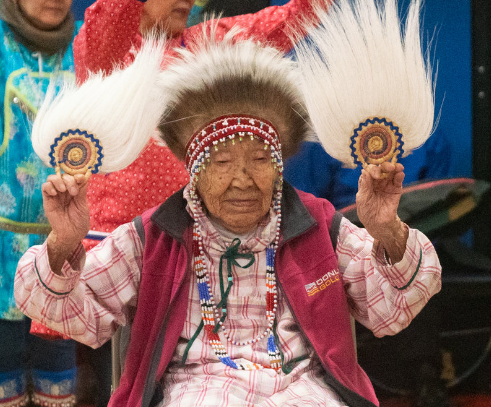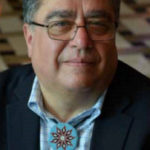
- Details
- By Levi Rickert
Commentary
Last Tuesday, 90-year-old Alaska Native and resident Lizzie Chimiugak became the first American counted by the U.S. Census Bureau in the remote village of Toksook Bay near the Bering Sea. Afterward, the Alaskan villagers celebrated with a community dance.
With this first census count kickoff, the 2020 Census is officially upon us. While April 1 is officially Census Day in the United States, the remoteness of some of the Alaska villages necessitates the Census Bureau beginning the census count early and the enumeration will continue.
The decennial census is mandated by the U.S. Constitution in Article I, Section 2. The number of people counted in the census helps predicate how federal dollars are allocated and provide the basis for drawing congressional district lines in the United States.
Arguably, the census is about money and power.
Money and power follow larger population counts; therefore, American Indians and Alaska Natives must make sure they are counted so the appropriate amount of money can flow into American Indian and Alaska Native communities. During the course of a decade, federal funding translates to billions of dollars made available throughout Indian Country for education, housing, employment, health and other essential needs, such as roads and infrastructure. Without an accurate count of American Indians and Alaska Natives, federal money remains inadequate to address the true severe needs in Indian Country.

It’s not just about money, though. Census counts also impact the distribution of power in the United States because an accurate count of the population serves as the basis for political representation. State population counts from the decennial census are used to reapportion seats in the U.S. House of Representative. The total of 435 never changes and is split across the 50 states. Therefore, states may gain or lose number of congressional seats based on census tallies. Results of the decennial census will be made known by December 31, 2020, which will ultimately impact the congressional election in 2022 and determine the number of Electoral College votes individual states will have in the 2024 presidential election.
All this impacts American Indians and Alaska Natives because of the Native vote, which has gained the attention of politicians who now view our votes as the tipping point in some elections.
Historic Undercounts of Native population
In the 2010 Census, the Census Bureau estimates that American Indians and Alaska Natives on reservations or in Native Alaskan villages were undercounted by about five percent, which represents double the rate of the next closest population rate. Back in 1990, the net undercount was estimated to be 12.2 percent. There are several factors that attribute to the undercounts among Native people.
One major factor that attributes to the undercounts among American Indians and Alaska Natives is where they live, such as remote areas in Toksook Bay, Alaska where nonagenarian Lizzie Chimiugak was counted.
The Census Bureau refers to remote or difficult areas as hard-to-count (HTC) tracts. Many tribal citizens in Indian Country live in HTC tracts. In New Mexico, 78.6 percent live HTC tracts, 68.1 percent in Arizona, 65.6 percent in Alaska, 52.4 percent in South Dakota, and 49.9 percent in Montana.
To prevent undercounts in HTC tracts, the Census Bureau sends census takers to homes. Tribes throughout Indian Country have been working closely with the Census Bureau to overcome the barriers to prevent undercounts of their tribal citizens.
Overcoming Past Apathy
In Lousie Erdrich’s 1984 National Book Award-winner Love Medicine, fictional character Lulu Lamartine, an American Indian activist, voices her distrust of the federal bureaucracy when she says:
“I never let the United States census in my door, even though they say it’s good for Indians. Well, quote me, I say that every time they counted us they knew the precise number to get rid of.”
 Levi Rickert
Levi Rickert
Even though Lulu Lamartine was a fictional character, her sentiments about attitudes relating to government involvement in the lives of the Native population ring true. The Indian boarding school era allowed for the removal of Native children from their familial homes so they could be taken hundreds of miles away to “kill the Indian and save the man.”
The attempt to strip American Indians of their culture left a scar that still lingers within families directly impacted by the removal. As a means to thwart the imposed removal, American Indians developed ways to hide their children and certainly never revealed to a census taker how many children were in their homes.
Thankfully that painful Indian boarding school era is now over, but some of the sentiment lingers. That must change.
In the 2020 Census, American Indians need not fear filling out the form, but should for the means of demonstrating pride in their communities fill it out completely with the full name of their tribe.
Just the Toksook Bay did in showing civic pride and duty towards the 2020 Census with a village celebration, all other American Indians and Alaska Natives—regardless of if they live on reservations or live in rural or urban settings, need to get past the apathy of the census and be counted by fulling participating in the census.
For more information about the U.S. Census and how to respond, visit https://2020census.gov/en/what-is-2020-census.html.
Levi Rickert (Prairie Band Potawatomi Nation) is the publisher and editor of Native News Online.
More Stories Like This
Biden Nominates Salish & Kootenai Tribal Attorney Danna Jackson for Federal BenchA Conversation With Lt. Gov. Peggy Flanagan: What We Can Celebrate Around the State
Return to the Heart Foundation Gives 44 Micro-Grants to Native Women Leaders
Indigenous Journalists Association President Addresses Members of the UNPFII
Inter-Tribal Council Passes Resolution Urging FCC to Establish Specific Event Code for Missing and Endangered Persons
Native Perspective. Native Voices. Native News.
We launched Native News Online because the mainstream media often overlooks news that is important is Native people. We believe that everyone in Indian Country deserves equal access to news and commentary pertaining to them, their relatives and their communities. That's why the story you’ve just finished was free — and we want to keep it that way, for all readers. We hope you'll consider making a donation to support our efforts so that we can continue publishing more stories that make a difference to Native people, whether they live on or off the reservation. Your donation will help us keep producing quality journalism and elevating Indigenous voices. Any contribution of any amount — big or small — gives us a better, stronger future and allows us to remain a force for change. Donate to Native News Online today and support independent Indigenous-centered journalism. Thank you.

